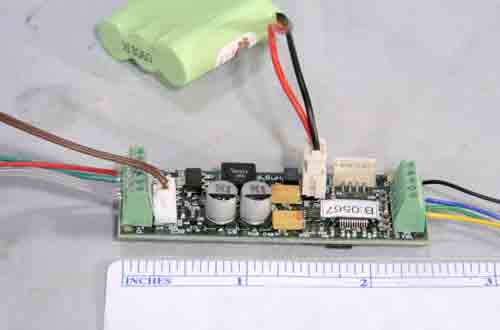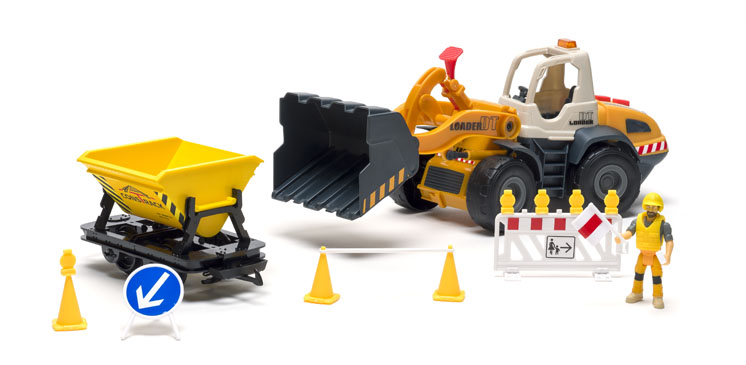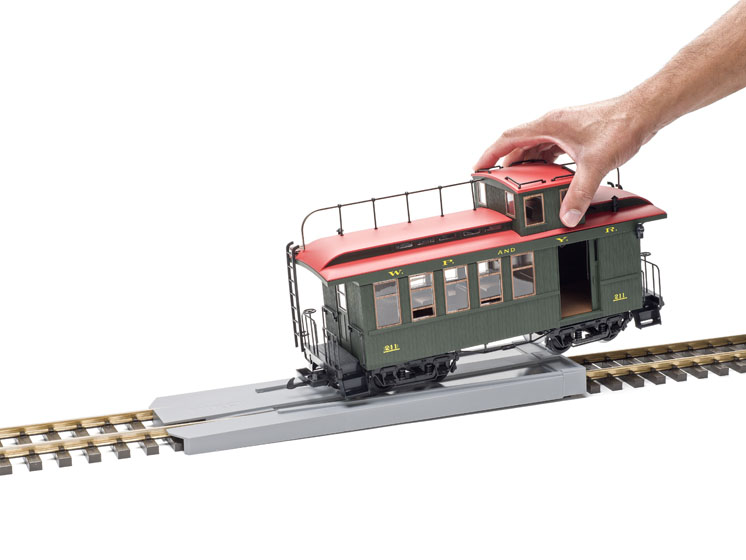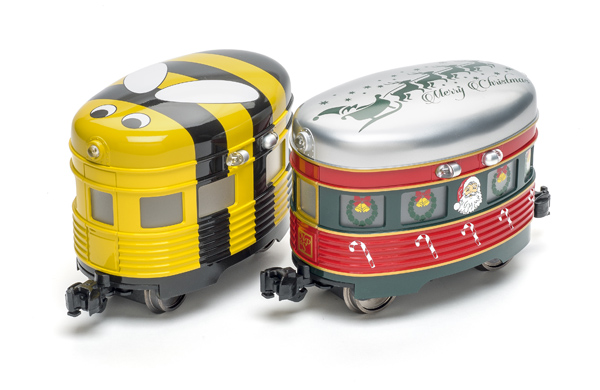Digital sound system for DC operation
Phoenix Sound Systems
3514 West Liberty Rd.
Ann Arbor MI 48103
Price: $245
Web site: www.phoenixsound.com
Phoenix PB9 sound board; can operate with DC track power, battery power, and DCC; several sound packages available; sounds configurable via CD (sold separately); includes speaker, 3.6V battery, sound board, volume-control switch, speed sensor/chuff trigger, and programming jack (for communicating with the PC). Dimensions: length, 2½”; width, 9/10″, height, ½”
Pros: Interfaces with most forms of model-train control; small size fits easily in most locomotives; clear sound reproduction; sounds can be customized via a CD-Rom PC interface (sold separately)
Cons: None
This is a universal sound board in that it’s compatible with most forms of train control. It works with regular DC track power, battery R/C, and DCC-based control systems. That’s a distinct advantage over other systems that operate solely on one method. You can reconfigure this board differently down the road, should you change your control method.
The sound system comes from the factory pre-programmed with any number of sound packages that Phoenix offers. Their web site has audio samples of each package. By itself, the board offers some basic controls over the sound. There are four external triggers, which can include track magnets, push buttons on the locomotive (useful for the ride-on scales or remote control), or DCC triggers. The board has four sound triggers, though is capable of triggering more independent sounds through an external circuit board. Still, four sounds will probably be adequate for most users.
Most of the sounds come pre-set to run automatically, either based on the speed of the train or randomly. For instance, for steam locomotives, there are sounds of the cylinders clearing condensate via the cylinder cocks when running at slow speed, as well as the sound of side rods clanking. They’re subtle, but they’re there. There’s a fireman shoveling coal, water injectors, air pumps, and generators-chances are if the steam locomotive makes the sound, it’s reproducible via this board.
The user can customize how certain sounds are played on the board itself. The bell and whistle can be set to ring and blow automatically, based on speed and direction, or to operate via triggers. Chuff can be set to operate from a trigger (magnetic reed switch, included) or by voltage. You can also program the board via a DCC interface if you’re using that to operate the board.
However, by far the “best” way to program the board is via a CD that Phoenix sells separately. This CD allows you to customize a number of sounds, to control the volume of each one individually relative to another (for instance, you might not want to hear the coal being shoveled quite as loudly as the whistle being blown) and-most importantly-choose the sound package you’d like to access. This means you can buy one board and, if you decide you want to move it from one locomotive to another (or you simply get tired of the sound and want to change it), you merely plug the board into your PC via the cable that comes with the CD and change things around. I did not review the PC interface with this board, since it’s a separate accessory. The software works with all of Phoenix’s sound systems, so you only need to buy it once. It is only Windows compatible but Mac users have had success running it with an emulator.
The system includes a speaker, 3.6V battery, the sound board, volume control switch, speed sensor/chuff trigger, and programming jack (for communicating with the PC). The 3.6V battery keeps the sound system functioning when track voltage drops below a certain threshold. If you’re using battery power, you’d plug your regular batteries into that port instead. The board can accept input voltages of up to 30V, which should be adequate for almost all forms of control. Note: the battery input is currently polarity sensitive, so make sure whatever you plug into that port is the right polarity. Phoenix tells me that future revisions of the board should remedy that.
At 21/2″ long, 9/10″wide, and 1/2″ tall, the board should easily fit into all but the tiniest of locomotives. There is a mixture of plugs for the speaker, battery, and PC interface, and screw terminals for the rest of the connections.
My review sample came pre-programmed with the “Mogul” sound package. Since each package is different, I’ll not comment on the specific sound qualities; suffice to say the Mogul sound is clean and a delight to hear. Obviously, the better the speaker and housing, the better the sound reproduction. Alas, our locomotives are seldom designed for acoustic superiority, so we inevitably compromise to a degree there anyway.
Installation was easy. The included manual has diagrams showing how to install the board with many of the popular control systems on the market today. I installed mine with Aristo-Craft’s “Revolution” control, which was not included in the instructions. Still, connection to the control system was a breeze, using other systems’ instructions as a guide.
I first ran the system on track power, using the 3.6V battery. The battery has to charge before it has any effect, so the sounds don’t spin up initially until the voltage reaches a certain point. Once the battery had a little charge on it, things settled down nicely. Control of the whistle, bell, etc. was good. I couldn’t do really short “toots” with the whistle, but that’s a function of the digital recording of that specific whistle. I’m told other sound packages have quicker responses. It’s still fairly quick-satisfactory for me.
I then connected the board to batteries in the tender of one of my locomotives and set off to the railroad to put the system through its paces. When the power is turned on, you get idle sounds like a slight blower hiss, water injectors and air pumps randomly going off, and the fireman shoveling coal into the firebox. When the locomotive starts to move, which the sound system senses from the speed sensor/chuff trigger, you get the “start-up” sounds. The generator spins up, and you hear sounds of condensation clearing via the cylinder cocks and rods clanking. I wish the generator sound was able to be keyed off of something other than the locomotive starting to move, since that’s something that’s typically either on or off (usually on), not something that gets turned on and off based on whether the locomotive’s moving or not.
After the locomotive picks up a little speed, the cylinder-cock and rod-clank sounds stop and you’re left listening to the cadence of the regular chuff. With the set-up from the factory, when the engine reached a certain speed, the whistle blew the standard grade-crossing signal (two longs, a short, and a long). On my locomotive, that sounds when the speed is just a little faster than I usually run, so I use it as a kind of speed limit-if it blows, I know I’m going too fast. (This is configurable via the PC interface). On slowing down and stopping, the board plays the sound of brakes being applied, coupler clank (if stopping from reverse), and steam hiss.
I’m impressed with this system. There are lots of sounds that will keep your ears interested in what’s going on. I prefer to hear locomotives fade away as they get further down the track, so I tend to run the system at the low end of the volume spectrum. Even at these low volumes, each sound came through clearly and discernably. On the upper end-and this system can get loud-I couldn’t hear any distortion, at least through the speaker I’m using. Phoenix is a name that’s been in the sound business for a while, and this system certainly lives up to their reputation.














